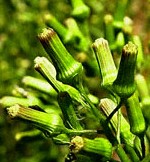 Also called burnweed and fireweed, pilewort is a summer annual native to the Americas but has been spread around the world. As the name implies, the plant profits from fire and is a pioneer species in recently burned areas. Although it prefers moist sites in full sun or shade fireweed is tolerant of dry soil. Pilewort can be found in a variety of disturbed areas such as along ditches and railroad tracks, in wooded areas, edges of marshes, open woodlands, and moist prairies. It is a member of the daisy family, Asteraceae and includes three varieties.
Also called burnweed and fireweed, pilewort is a summer annual native to the Americas but has been spread around the world. As the name implies, the plant profits from fire and is a pioneer species in recently burned areas. Although it prefers moist sites in full sun or shade fireweed is tolerant of dry soil. Pilewort can be found in a variety of disturbed areas such as along ditches and railroad tracks, in wooded areas, edges of marshes, open woodlands, and moist prairies. It is a member of the daisy family, Asteraceae and includes three varieties.
Description
Pilewort has a round, hairless central stem with vertical green ridges and grows two to eight feet tall. The stem is sometimes branched at the top and carries coarsely serrate or dentate leaves that are up to eight inches long and three inches wide at the base but gradually decline in size as they grow on the stem. The flowerheads are produced in panicles and resemble buds rather than flowers. They are ¾ inch long and enclosed in green bracts that sometimes have a purple tint. Flowering occurs for three weeks in late summer or early fall and is followed be the production of small, one seeded fruits called achenes that carry tufts of white hair and probably account for the common name pilewort. The root system is shallow and fibrous.
Control
Because pilewort is an annual removal before seed production is essential for control. Plants rarely grow in thick stands and can be easily removed from the garden by hand pulling.